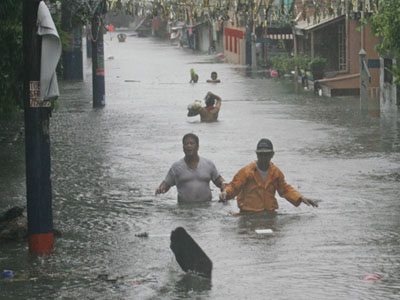The deadliest typhoon in the recorded history of Taiwan formed over the open Pacific Ocean within a monsoon trough on August 2, 2009, about 998 km (620 mi) east of the northern most Philippine Islands over the open Pacific Ocean. This initial tropical depression was very weak and was actually downgraded to an area of low pressure before it regained tropical depression status. The depression moved east and then north around a low level ridge of pressure until it developed into a tropical storm on 4 August. At this time, deep convection began building toward the storm’s center. On 5 August, Tropical Storm Morakot developed into a typhoon. Barometric pressure decreased steadily as the typhoon strengthened. The typhoon reached its peak intensity early on 7 August with a low pressure of 945 mb (hPa) and sustained winds of 161 km/h (100 mph), equivalent to a Category 2 hurricane. Later that day, Typhoon Morakot made landfall in central Taiwan. About 24 hours later, the storm moved off the west coast of the island and into the Taiwan Straight where it turned north-northwest. On 9 August Morakot made its final landfall as a severe tropical storm in Xiapu County, China, on 9 August, as a severe tropical storm with winds between 88-116 km/h (55-72 mph). The storm weakened to tropical depression over China, curved toward the northeast, and then dissipated completely on 11 August over the extreme lower Yellow Sea.
Typhoon Morakot produced tremendous rainfall over Taiwan. Over 2,769 mm (109 in) fell, breaking the previous single-typhoon record of 1736 mm (68.4 inches) that fell over the country during during Typhoon Herb in 1996. Floodwaters were so severe that they breached 36.2 km (22.6 mi) of levees along major rivers, and damaged a total of 9.6 km (6 mi) of those levees, while 0.5 km (0.3 mi) of sea wall was breached with 0.18 km (0.11 mi) damaged. The heavy rains also triggered mudslides that caused catastrophic damage. The entire town of Siaolin in Taiwan’s Central Mountain Range was buried during one of the landslides, causing over 400 casualties. The township of Namaxia, in the south-central part of the island, became isolated after mudslides blocked or destroyed all roads leading into it. Typhoon Morakot caused 1.59 million residents in Taiwan to lose power and left 769,000 without running water. Another result of the heavy rainfall was major agricultural losses, estimated to be $494 million (2009 USD, 2009 $16.5 billion TWD). The tourism industry in Taiwan was also significantly impacted, with losses estimated to be $24.4 million (USD). At least 698 people are confirmed killed in Taiwan, though it is probable that many more perished. Total damages amount to $3.3 billion USD (TWD$110 billion). Damage in the Philippines was also significant. The typhoon affected some 29,000 people in the country, with 13,000 rendered homeless. On 6 August, 11 villages were flooded with 1.2-1.5 m (4-5 ft) of water after the Pinatubo Dike, on the northern most island of the Philippines, overflowed in response to the heavy rains associated with Morakot. Landslides were problematic here as well, causing roads to be closed and killing 12 miners who died when a landslide caused their mine to collapse. In China, the typhoon caused similar damages from flooding and landslides. In Xiapu County, 500 km (312 mi) south of Shanghai, 136,000 people, from 14 townships, reported damage to their homes due to floods or landslides. In the Zhejiang Province in eastern China, 3.4 million people reported property damage with at least 1,600 homes being completely destroyed. Typhoon Morakot caused an estimated $1.4 billion in damage throughout China. |


